Medieval Movies: Magic and Misery in 1,000 Years of Darkness
A survey/list of the best medieval movies from the 1930s to the 2020s.

The Medieval Era, also known as the Middle Ages or Dark Ages, is typically thought to have begun with the fall of the Roman Empire in the year 476 and ended with the fall of Constantinople to the Ottoman Empire in 1453. It was preceded by the Classical Era and followed by the Renaissance and is generally regarded as a time of great suffering and a marked drop in literacy and culture throughout Europe. After the year 700, much of this era is marked by endlessly bloody clashes between Christendom and the Islamic world, culminating in the Crusades. It was also characterized by clashes between Viking pagans in Scandinavia and Christian Europeans to the south.
Medieval movies are period dramas set during this thousand years of darkness. They are notable for their grittiness and their focus on emotional resilience and brute force to overcome titanically grueling periods such as the Black Death, which killed an estimated third to half of Europe’s entire population in the span of only four years—1347-1351.
Although times change and the world can’t help but get more modern, filmmakers continue to return to the Middle Ages because it was a time rich in both magic and misery. Here are some quintessential medieval movies.
Best Medieval Movies
The Adventures of Robin Hood (1938)
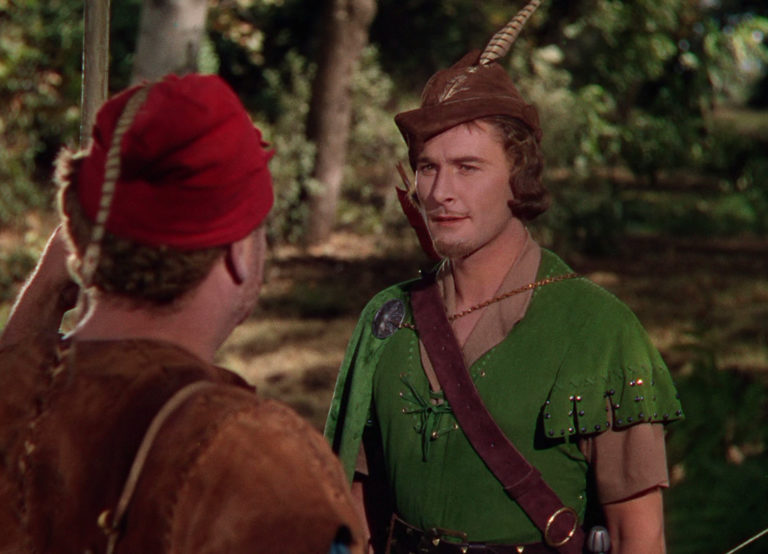
Although it’s uncertain whether Robin Hood ever even existed, the legend that emerged around a renegade archer who steals from the rich and gives to the poor is a cornerstone of British folklore. This film is set in the year 1191, after England’s King Richard the Lionhearted has been captured by the Austrian king, leaving British peasants under the ruthless dominion of Richard’s brother, King John. Legendarily dashing Hollywood leading man Errol Flynn plays the title role as the leader of renegades who fight oppression by dwelling in Sherwood Forest. Olivia de Havilland plays his love interest, the beautiful Maid Marian. An early example of a Technicolor film, The Adventures of Robin Hood’s producers used all 11 Technicolor cameras in existence to film it. Fun trivia fact: The sound of Robin’s arrow sailing through the wind has been used in all of the Star Wars films. Roger Ebert writes, “In these cynical days when swashbucklers cannot be presented without an ironic subtext, this great 1938 film exists in an eternal summer of bravery and romance. We require no Freudian subtext, no revisionist analysis; it is enough that Robin wants to rob the rich, pay the poor and defend the Saxons not against all Normans, only the bad ones: ‘It’s injustice I hate, not the Normans.’”
Seven Samurai (1954)

Although widely ignored and panned in its native country upon its release, Akira Kurosawa’s legendary Seven Samurai (Shichinin no samurai) was voted in 2000 by a group of critics as the greatest Japanese film of all time. Considered by many to be the first action movie, it was the direct inspiration for the 1960 American Western thriller The Magnificent Seven. Set in feudal Japan in the 1500s, the movie tells the tale of a small, impoverished village being subjected to ceaseless attacks from roving bandits. The villagers decide to employ the skills of seven samurai to protect them. Filmmakers actually spent months of research building the characters from actual historical samurai. But tensions between the villagers and the samurai erupt when the latter feel that they aren’t being rewarded or appreciated by the villagers. A Film a Day writes, “With a very simple, straightforward story, Kurosawa beautifully portrayed two cultures of Japan, farmers and samurai, which are very different one from the other, and that eventually come together to defend the values of their nation, a Japan deeply torn apart by civil wars. And he did that extremely slowly, but this way it’s easier to get to know the characters and care for them.”
The Seventh Seal (1957)

Widely considered to be Swedish director Ingmar Bergman’s masterpiece, The Seventh Seal (Det sjunde inseglet) is set in medieval Sweden just as the Black Plague begins devastating Europe. A Swedish Knight named Antonius Block (Max von Sydow) returns from fighting in the Crusades to find that his countrymen are all perishing. When Death—yes, that’s actually a character in the film, although it’s merely actor Bengt Ekerot wearing a hooded robe—approaches Antonius and tells him that his time has come, Antonius challenges Death to a chess match in which Antonius is allowed to survive if he wins. As the two square off on the chessboard, misery and suffering surround them. Paste magazine writes, “Amid black plagues, witch hunts, passion plays and bawdy songs, the knight (and Bergman himself) digs deep into such dark ages and finds a kernel of affirmation.”
The Valley of the Bees (1968)

Released in Czechoslovakia as Údolí vcel, this film is by director František Vláčil, whose 1967 movie, Marketa Lazaroví¡, is also set in the 1200s and is considered the greatest Czech film of all time. Valley of the Bees tells the story of a young boy named Ondrej, who loves bees and bats. After being paralyzed in an altercation with his abusive father, Ondrej is sent to live under the oppressive climate of a medieval Christian monastery—an environment that turns out to be as abusive toward him as his family was. Electric Sheep Magazine calls the film “a simply told tragedy and a stinging critique of ideology, oppression and the loss of free will, ostensibly during the Crusades….Valley of the Bees is a visually stunning, hypnotic and disturbing film that has managed to remain totally relevant, stylistically and politically.” Cine Outsider writes, “Rather than fighting this darkness, The Valley of the Bees gives into and immerses itself in it, producing a film that’s brave, thought-provoking and contentious. Aesthetically, it’s breathtaking to look at, and emotionally, it’s hard to endure, which makes for an incredibly potent experience.”
Monty Python and the Holy Grail (1975)

Monty Python was a mostly English comedy troupe (Terry Gilliam was the only American) who first gained international fame with their 1969-1974 BBC show Monty Python’s Flying Circus. This is their first film after the TV show folded, and it was such a raging success in America that it became the USA’s highest-grossing British film in 1975. It’s based on the legend of King Arthur (Graham Chapman), who enjoins his squire (Terry Gilliam) and the Knights of the Round Table (Michael Palin, Eric Idle, Terry Jones, and John Cleese) in their quest for the grail that Jesus allegedly consecrated during the Last Supper. The film portrays medieval England as a place filled with dirt, blood, disease, and misery. The BBC writes about the film’s unique fusion of medievalism and comedy: “Immortal are the Knights who say ‘Ni,’ the guard who doesn’t hiccup but tries to get things straight, the killer bunny rabbit, the extraordinarily rude Frenchman, the Bridge of Death over the Gorge of Eternal Peril, the Black Beast of Aarrgghh, and the three-headed knight. But what is best remembered is the duel fought with the brave Black Knight whose limbs are lopped off one by one. Even then he is still indomitable, and as a still-upright torso he calls after his victor, ‘Come back here…I’ll bite your legs off.'”
Excalibur (1981)

Like so many medieval movies, Excalibur builds upon the legend of King Arthur, the Knights of the Round Table, and Camelot. The titular sword Excalibur has a mystical power that it will grant to anyone who is able to pry it out of the rock into which it was plunged by Merlin the magician. Whoever is able to wield Excalibur will be granted dominion over England. Slant magazine writes, “John Boorman’s Excalibur plays by its own set of rules. The epic medieval tale reimagines Sir Thomas Malory’s Le Morte d’Arthur as a glistening collection of ornate iconography, deconstructing familiar characters and references to create a fantastical hyper-realized version of medieval folklore.”
Knightriders (1981)

Although not technically a medieval movie because it’s set in the present, this high-spirited thriller by George A. Romero (Night of the Living Dead) follows the members of an itinerant Ren Faire who travel around the country recreating medieval jousting matches…but on motorcycles instead of horses. King Billy (Ed Harris) tries to maintain cohesion among the group despite the fact that it’s beginning to crack under the pressure of personal rivalries and harassment by rural cops. Director George A. Romero said that his original cut of the film lasted about 17 hours. Horror fans will be delighted to know that Stephen King has a cameo as “Hoagie Man,” an obnoxious and foul-mouthed fan of Ren Faire. Time Out writes, “George Romero’s modern-dress ‘Morte d’Arthur’ fuses medieval chivalry and post-‘Easy Rider’ utopianism to glorious effect…the stunts look nail-bitingly real, the characters feel raggedy and lived-in, and the film’s core message – that independence is paramount, that corporate America eats its young – is one close to Romero’s heart.”
Ran (1985)

Legendary Japanese director Akira Kurosawa (Seven Samurai) returns toward the end of his career with a with a medieval Japanese twist on Shakespeare’s King Lear. Lord Hidetora (Tatsuya Nakadai) is an aging feudal ruler who seeks to step down from authority. He wants to partition his domain to his three sons—two of whom insincerely flatter him and the youngest of whom winds up suffering because he’s completely honest with his father and tells him things that he probably doesn’t want to hear but needs to hear. Roger Ebert writes, “Akira Kurosawa’s ‘Ran’ is inspired by ‘King Lear,’ but may be as much about Kurosawa’s life as Shakespeare’s play. Kurosawa has not told the story of a great man whose sin of pride drives him mad, but the story of a man who has waged war all his life, hopes to impose peace in his old age, and unleashes even greater turmoil.”
Deadtime Stories (1986)

Released internationally as The Griebels From Deadtime Stories and Freaky Fairy-Tales, this American anthology horror comedy film revolves around a babysitter named Uncle Mike (Michael Mesmer), who desperately tries to get his nephew to fall asleep by telling him three different bedtime stories. In “Little Red Running Hood,” the Big Bad Wolf is actually reformed and nice, but a teenage girl mistakenly gives the wolf’s medication to her grandmother, with disastrous results. “Goldi Lox” is a humorous updated version of the Goldilocks tale, but with a Jewish twist. “Peter and the Witches” is the only tale of the three that is based in medieval times. It involves a slave who is used by two witches in an attempt to resurrect their sister. When Uncle Mike’s original ending to “Peter and the Witches” proves to be too dark and upsetting for his nephew, he revises it and gives it a more wholesome ending. Some of the sequences in this segment were so gory that cowriter/director Jeffery Delman had to make cuts to get an “R” rating instead of an “X” rating—the latter of which was the equivalent of NC-17 back in the 1980s.
Ladyhawke (1985)

A young Matthew Broderick stars as Phillipe Gaston, a lowly pickpocket known mostly as the “Mouse” who escapes punishment in a medieval dungeon when he is rescued by a dashing knight in black armor named Etienne Navarre (Rutger Hauer). Navarre is in love with Isabeau d’Anjou (Michelle Pfeiffer), who by day transforms into a hawk; by night, Navarre transmogrifies into a wolf. These would-be lovers are condemned to become animals due to a curse by an evil bishop who was jealous of their romantic bond. The Movie Scene UK writes, “The daft thing is that is about it as ‘Ladyhawke’ is simply a fun, action-packed adventure movie with a small fantasy side….‘Ladyhawke’ is a fun movie which whilst technically a fantasy movie is not as pretentious and out there as some 80s fantasy movies. In fact, ‘Ladyhawke’ is more of an old-fashioned adventure movie with a perfect mix of swashbuckling action and humor.’
The Name of the Rose (1986)

Sean Connery stars as William of Baskerville, a free-spirited and intellectually renegade 14th-century Franciscan monk who arrives along with his young protege at a Roman monastery during the Middle Ages. As William seeks to solve a mysterious string of deaths at the monastery, his path leads him to a library containing books that suggest the murderer’s true identity. But the further he delves into solving the mystery, the more he realizes that he’s going up against an authoritarian Church and a cabal of monks who have a vested interest in William never finding the murderer. Roger Ebert writes that Sean Connery portrays William “as the first modern man, as a scholar-monk who understands all of the lessons of the past but is able to see them in a wider context than the others of his time.”
The Navigator: A Medieval Odyssey (1988)
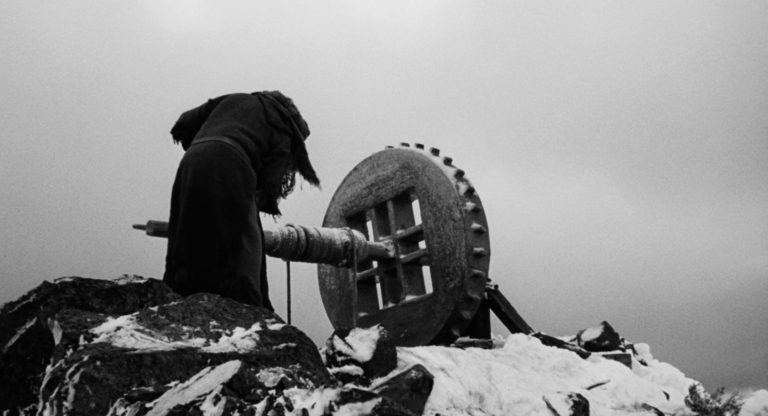
This intriguing time-travel thriller by writer/director Vincent Ward begins in the northwestern English village of Cumbria in the year 1348, when the Black Death was ravaging Europe. A young boy named Griffin (Hamish Gough) starts receiving strange visions as the Black Death creeps toward his town. His vision tells him that to escape the plague, he and some villagers will have to dig a hole to the other side of the world. They do this, only to wind up in New Zealand during the modern era. Rock! Shock! Pop! writes, “While all the performances in the film are solid, [Hamish Gough] is the real prize, an actor of striking durability at so young an age, one capable of stealing a film from a stable of superlative adult performers.”
Henry V (1989)
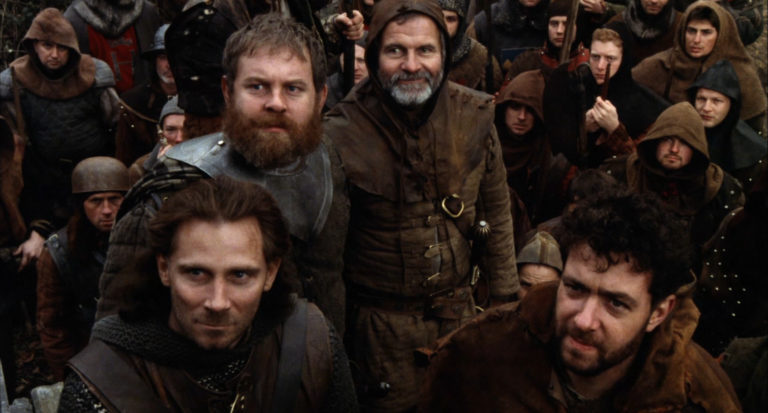
In his directorial debut, Kenneth Branagh adapts William Shakespeare’s classic play Henry V. Branagh also stars in the title role as King Henry V of England, who leads his country in the Hundred Years’ War during a fresh military assault on France. Henry takes the war personally because he’s been insulted by France’s King Charles VI (Paul Scofield). As he leads his soldiers into France, Henry is beset by self-doubt and his troops’ low morale. Branagh was nominated for Best Director and Best Actor, but the film’s only Oscar went to Phyllis Dalton for Best Costume Design.
Robin Hood: Prince of Thieves (1991)

Kevin Costner, wearing the same historically inaccurate 1990s “mullet” haircut he wore in Dances With Wolves, stars in yet another retelling of the English folk legend about a skilled archer who attempts to redistribute England’s wealth among its peasantry. Morgan Freeman stars as Robin Hood’s best friend, a Moor who was relocated to England as a result of the tumult of the Crusades. Christian Slater plays a hotheaded young protege of Robin Hood’s whose behavior must be kept in check. While complaining about the movie’s excessive gore, Roger Ebert notes the film’s socialist sympathies: “The movie casts Robin Hood as sort of a populist guerrilla, a Che Guevera with bow and arrow who lives with his followers in Sherwood Forest and intercepts the king’s mail by using tunnels and camouflaged hiding places under the forest floor, Viet Cong-style.”
Braveheart (1995)
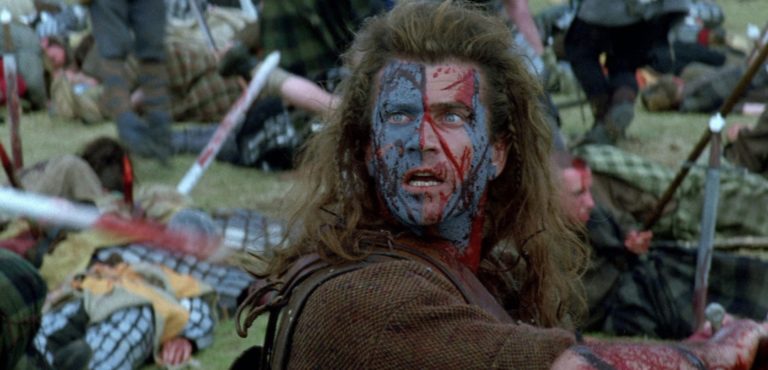
In this film that won four Oscars—Best Picture, Best Director, Best Cinematography, and Best Makeup—Mel Gibson stars as William Wallace, a legendary Scottish soldier who encouraged his countrymen to take up arms against the oppressive and exploitive rule of his country’s land by British interlopers. Mel Gibson said that it didn’t matter if the film took liberties with historical facts: “We romanticized it a bit, but that’s the language of film—you have to make it cinematically acceptable. Actually, [William Wallace] was a monster—he always smelled of smoke because he was always burning people’s villages down. He was like what the Vikings called a ‘berserker.’ But we kind of shifted the balance a bit, because somebody’s got to be the good guy and somebody the bad guy, and every story has its own point of view. That was our bias.” Roger Ebert writes, “It’s an ambitious film, big on simple emotions like love, patriotism and treachery, and avoids the travelogue style of so many historical swashbucklers: Its locations look green, wet, vast, muddy and rugged.”
A Knight’s Tale (2001)

In a film that was partially inspired by Geoffrey Chaucer’s The Canterbury Tales, Heath Ledger stars as a lowly peasant named William Thatcher, who seeks to win a fetching maiden’s affection by developing a reputation as a skilled medieval jouster. The film is notable for the fact that even though it is set in the Middle Ages, classic rock songs such as Queen’s “We Will Rock You” play during the action scenes. Along the way back home from winning a jousting competition, Thatcher befriends a young writer named Geoffrey Chaucer, whom he persuades to forge some genealogy papers to make Thatcher eligible for knighthood. Roger Ebert writes, “The movie has an innocence and charm that grow on you. It’s a reminder of the days before films got so cynical and unrelentingly violent. ‘A Knight’s Tale’ is whimsical, silly and romantic.”
Kingdom of Heaven (2005)
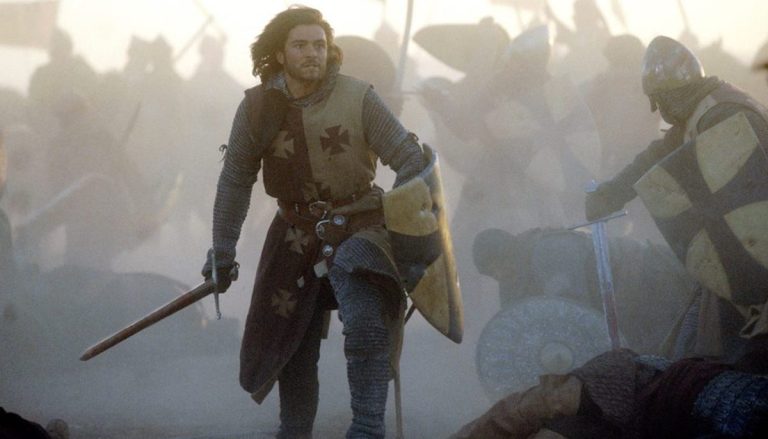
In this epic adventure by action maestro Ridley Scott, Orlando Bloom portrays Bailan of Ibelin, a French blacksmith-turned-mercenary who travels to Jerusalem during the Crusades of the 12th century and finds himself thrust into the position of becoming the Holy City’s primary defender after King Baldwin (Edward Norton) dies of leprosy. He is then forced to face a Muslim onslaught by troops led by the infamous Saladin (Ghassan Massoud). Roger Ebert writes, “‘Kingdom of Heaven’ is better than ‘Gladiator’—deeper, more thoughtful, more about human motivation and less about action.”
Black Death (2010)

Set in the year 1348—the peak of the bubonic plague outbreak that devastated and almost annihilated Europe—a legend emerges about a small village deep in the English marshlands that is so remote, the Black Death has yet to reach it. Rumors have emerged from the village about a necromancer who has the rare ability to resurrect people from the dead. The church tasks a warrior knight named Ulric (Sean Bean) to investigate these nefarious rumors. Osmund, a young monk who travels along with Ulric on his mission, discovers that the necromancer is actually a beautiful witch named Langiva, who offers him her affections in exchange for his soul. Screen Anarchy writes, “Black Death touches on themes that are relevant today; fear mongering. exploitation and manipulation of fear, religious zeal, questions of strength of devotion, why has thou forsaken us? There is plenty to chew on.”
Season of the Witch (2010)
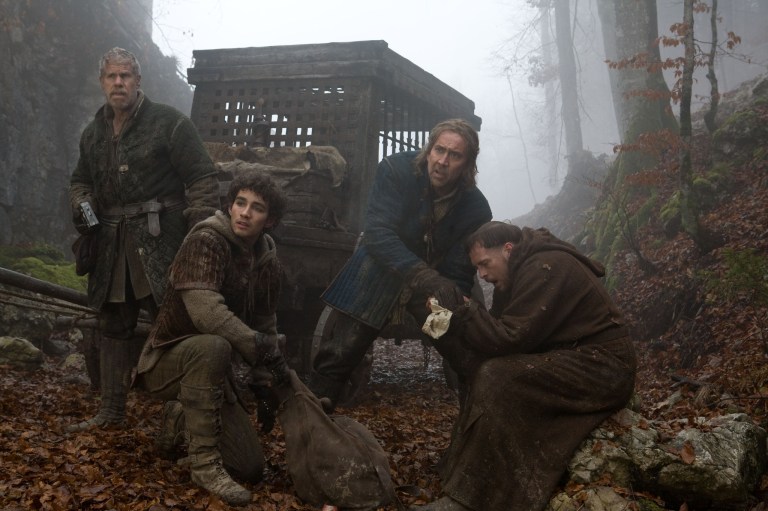
Oscar-winning actor Nicolas Cage stars as Behmen, a crusading knight who’s returning from the Middle East with his trusty partner, Felson (Ron Perlman), when he starts to develop a crisis of conscience and faith due to the unending death and bloodshed he’s witnessed all around him. When they arrived at the Palace of Marburg, a Cardinal commands them to deliver a witch (Claire Foy) to a local abbey for trial. The witch is suspected of being responsible for the Black Plague. En route to the trial, Felson and Behmen discover that the woman isn’t being falsely accused—she is indeed a witch and is possibly responsible for all of the horrors befalling Europe.
More Medieval Movies

- The Passion of Joan of Arc (1928) in this silent drama, Renee Falconetti stars as the French heroine who was burned at the stake for heresy in the year 1431, only to be canonized as a saint hundreds of years later.
- Alexander Nevsky (1938) is an epic war film by Sergei Eisenstein about a Russian national hero who fought the Mongols coming from the east and the Germans coming from the west in the 1200s. The “Battle on the Ice” segment, based on an actual clash between Russians and Germans on a frozen lake in the year 1242, is considered by many to be the best war scene in film history.
- Richard III (1955) Sir Laurence Olivier portrays the famous King of England and Lord of Ireland who lived from 1452-1485.
- El Cid (1961) Charlton Heston stars in the title role as the legendary Spanish warlord of the 11th century. Sophia Loren portrays his love interest.
- The Sword in the Stone (1963) in this animated feature, Merlin the Magician trains young Arthur to become the next King of England.
- Becket (1964) Peter O’Toole stars as Henry II of England, who appoints the upstart Thomas Becket (Richard Burton) as the nation’s Chancellor.
- The Lion In Winter (1968) as internecine family squabbles threaten the reign of King Henry II (Peter O’Toole in the same role again!), a struggle erupts to determine his successor.
- Valhalla Rising (2009) a one-eyed Viking and a runaway encounter danger in this Nordic-based historical thriller.
- How to Train Your Dragon (2010) an animated feature in which a young Viking befriends a dragon and together they team up to save the world.
- Ironclad (2011) a group of upstart warriors in 13th-century England seeks to dethrone the king.
- The King (2019) an upstart prince named Hal is crowned King Henry V after his father dies, leaving him to manage a messy situation he wanted no part of.
- The Last Duel (2021) is based on a true story from 14th-century France. Two knights (Matt Damon and Adam Driver) must duel to the death to defend a woman’s honor.
- The Green Knight (2021) is based on Arthurian legend and is a fantasy movie from A24.
